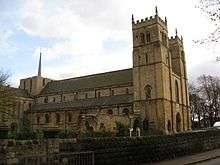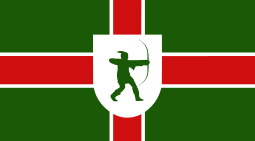Worksop Priory
Coordinates: 53°18′13″N 01°06′56″W / 53.30361°N 1.11556°W
| Worksop Priory | |
|---|---|
| The Priory Church of St Mary and St Cuthbert | |
 Worksop Priory | |
| Denomination | Church of England |
| Churchmanship | Anglo Catholic |
| Website |
www |
| History | |
| Dedication | St. Mary and St. Cuthbert |
| Administration | |
| Parish | Worksop Priory |
| Archdeaconry | Newark |
| Diocese | Southwell and Nottingham |
| Province | York |
| Clergy | |
| Bishop(s) | Glyn Webster, Bishop of Beverley (PEV) |
| Vicar(s) | Fr Nicolas Spicer SSC |
| Assistant priest(s) | The Rt Revd Martyn Jarrett SSC |
| Honorary priest(s) |
Fr Brian Cooper Fr Michael Dobbs Fr Alan Hirst Fr Bill Howe Fr John Statham |
| Asst Curate(s) | Fr Stephen Parker SSC |
Worksop Priory (formally the Priory Church of Saint Mary and Saint Cuthbert, Worksop) is a Church of England parish church and former priory in the town of Worksop, Nottinghamshire, part of the Diocese of Southwell and Nottingham and under the episcopal care of the Bishop of Beverley.
The church is Grade I listed by the Department for Culture, Media & Sport as a building of outstanding architectural or historic interest.
History

The initial land grant and monies to establish the Augustinian priory were made by William de Lovetot in 1103. In the 14th century the Tickhill Psalter was produced by the prior, John de Tickhill.
The priory was dissolved on the orders of Henry VIII on November 15, 1539. The property was granted to Francis Talbot, 5th Earl of Shrewsbury on condition that the Earl should provide a glove for the right hand of the sovereign at the coronation. This tradition continues to this day.
Over time most of the former monastic buildings were plundered for their stone, but the nave of the church was saved for use as a parish church, and the early 14th century gatehouse was used as a school. Extensive restoration and enlargements of the church began in the mid-19th century and continued through the 20th century.
Repairs and restorations
- 1760 A western gallery was erected across the nave.
- 1784 A gallery was erected along the north side.
- 1845–49 A restoration by R. Nicholson of Lincoln. The church was re-roofed, new foundations were provided to the south tower and the pillars and south aisle were pulled back to vertical.
- 1879 New organ by Brindley & Foster of Sheffield.
- 1883 Repairs to the south tower. Two bells added increasing the ring from six to eight.
- 1912 Gatehouse restored.
- 1922 Lady chapel restored by Thomas Pepper and re-dedicated.
- 1929 Opening up of the south transept.
- 1932 Building of the north transept and turret to the central tower.
- 1935 Blocking walls at the end of the nave were removed, creating a single space between the nave and transepts.
- 1974 Choir built by Laurence King. New organ by Peter Collins.
Priors of Worksop
|
|
|
Vicars of Worksop
|
|
|
|
Organ
The painted organ case was designed by Peter Collins, in co-operation with the architects, Laurence King and Partners, and constructed in mahogany in its main parts with pine-cored block wood panels. The case has a tonal as well as an architectural function, mixing the sound of the pipes and projecting it forwards as a blended whole. The specification was drawn up by David Butterworth and is almost identical to that of St. Mary's Church, Nottingham.
The pipes, of which there are 1634, are of various materials ranging in tin content from 90% in the façade pipes to 20% for some flute stops. Copper and pine are used for other registers. With the exception of 24 small pipes in the pedal case, all the front pipes are speaking. The reed pipes are by Giesecke of Germany; the flues by Stinkins of Holland and Peter Collins; the Cymbelstern is from Laukhuff, also of Germany.
The console at the foot of the central display pipes is constructed of oak; the naturals are of hard ‘blackwood' and the accidentals are white resin topped. The manual compass is of 56 notes; the pedal compass of 30 notes.
The style of voicing and the general approach to its construction has origins in the 17th and 18th centuries, rather than the more familiar instrument to be found in England. The balance of stops is in keeping with classical registration and the ‘Werk-Prinzip' of the case is designed to project the sound into the priory building.
For the mechanism of the key and pedal action, direct connection by trackers of thin wood are used to the control valves, giving the performer control over the attack and decay of each note. The stop action is electric. There are six pistons to each department and six toe levers for the pedal department. There are also eight general pistons.
The organ was reconstructed in 1996 by Wood of Huddersfield. It was cleaned and regulated and the soundboards were reconstructed. The keys were renewed; Swell Octave 2 ft replaced with new pipework by Stinkens; Cymbelstern added; entire stop action (slider solenoids excepted) was remade
with Alan Taylor solid state; sequencer added.
|
|
|
Organists
- John Hilton Turvey c. 1840[1]
- George Walker ???? - 1854[2] - 1861[3] - ????
- F. Staton ????–1865–1879[4]
- Hamilton White c. 1880[5]
- Revd. J.T. Bingley c. 1887[6] - 1891[7]
- Thomas Pickford 1891 – 1892[8] - ???? (formerly organist of Christ Church, Banbury)
- H.J. Greenfield ???? - 1920[9]
- John Newton 1920 - ???? (formerly assistant organist of St Edmundsbury Cathedral)
- Stanley H Mayes ???? - 1923[10]
- Cecil Victor Berry
- Ellis White
- David Burnham
- Leslie Carrick Smith
- Michael Overbury
- Mark Rothman 2016- present
Services
Sundays
- Solemn Mass with Sunday School at 9.30am
- Holy Baptism at 11.30am (second and fourth Sundays)
- Vespers and Benediction at 6.00pm
Weekdays
- Morning and Evening Prayer are normally said
at 9.00am and 6.00pm.
Mass times
- Monday, Wednesday and Saturday at 9.30am
- Tuesday and Thursday at 6.30pm
- Friday at 12.00pm, usually followed by a charity soup lunch
Pictures
See also
- Abbeys and priories in England
- List of English abbeys, priories and friaries serving as parish churches
References
- ↑ York Herald - Saturday 18 July 1840
- ↑ Nottinghamshire Guardian - Thursday 6 April 1854
- ↑ Nottinghamshire Guardian - Thursday 19 September 1861
- ↑ Sheffield Independent - Monday 28 April 1879
- ↑ Sheffield Daily Telegraph - Tuesday 27 January 1880
- ↑ Sheffield Independent - Thursday 29 December 1887
- ↑ Sheffield Daily Telegraph - Monday 12 October 1891
- ↑ Sheffield Independent - Wednesday 23 November 1892
- ↑ Sheffield Evening Telegraph - Saturday 10 January 1920
- ↑ Derby Daily Telegraph - Thursday 28 January 1943
- A brief history of Worksop Priory. Worksop Priory website (accessed 24 December 2005).
- White, Robert (1875) Worksop, The Dukery, and Sherwood Forest. Transcription at Nicholson, AP: Nottinghamshire History (Accessed 24 December 2005).
- Priory Music
External links
- Official website
- Diocese of Southwell and Nottingham
- Pipe organ information
- The Priory: its foundation and Dissolution
